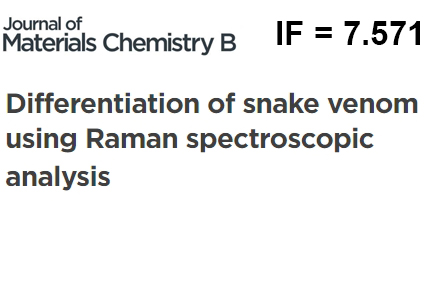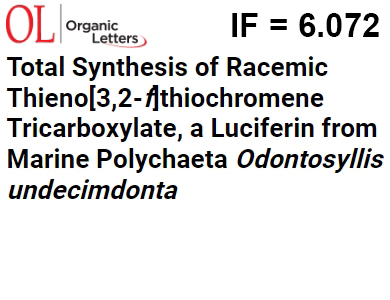Press-room / Digest

Classification of snake venoms using Raman spectroscopy
Snake venoms are complex, predominantly protein, mixtures. To assess the composition of snake venoms, a team of scientists from IBCh RAS and GPI RAS proposed a method based on Raman spectroscopy, which does not require sample preparation, and the necessary amount of samples is extremely small. Raman spectrum of a protein contains unique information about its primary and secondary structures. Authors conducted a study of dry venoms of various snake species from different genera and families. On the basis of the spectra, with the help of mathematical methods, a classification of venoms was carried out, reflecting their composition and the assignment of a producing snake to the corresponding family or even genus. The method can be used to analyze composition and variations of venoms. The results are published in Journal of Materials Chemistry B. Learn more

Total synthesis of racemic thieno[3,2-f]thiochromene tricarboxylate, a luciferin from marine polychaete Odontosyllis undecimdonta
The luciferin of the bioluminescent system of O. undecimdonta, which emits green-blue light, is an unusual heterocycle with previously unknown thieno[3,2-f]thiochromene skeleton. Despite numerous methods for the synthesis of benzothiophenes and thiochromenes, no synthetic approaches to thieno[3,2-f]thiochromenes have been proposed so far. The researchers from the Laboratory of Chemistry of Metabolic Pathways developed a convergent synthetic pathway to thieno[3,2-f]thiochromene tricarboxylate via cascade reactions with the use of bifunctional reagents, which afforded the structural confirmation of Odontosyllis undecimdonta luciferin and opened the route to other thieno[3,2-f]thiochromenes that were not accessible via known synthetic methods. The research was published in Organic Letters. Learn more

Effects of cobra cardiotoxins on intracellular calcium and the contracture of rat cardiomyocytes depend on their structural types
Scientists from the Department of Molecular Neuroimmune Signaling IBCh RAS together with colleagues from the Institute of Cell Biophysics and the Institute of Theoretical and Experimental Biophysics, studied the effect of cobra venom cardiotoxins on the intracellular concentration of calcium ions and the shape of rat cardiomyocytes (CaTx). Depending on the structure of the N-terminal or the central polypeptide loop, CaTx are classified into either group I and II or P- and S-types, respectively. It was shown that CaTxs of group I containing two adjacent proline residues in the N-terminal loop were less toxic to cardiomyocytes than group II toxins and CaTxs of S-type were less active than P-type ones. So, it was demonstrated that the CaTx toxicity to cardiomyocytes depends on the structures both of the N- terminal and central polypeptide loops. The paper was published in the International Journal of Molecular Sciences. Learn more

Alterations in the CD56 and CD56 T Cell Subsets during COVID-19
Scientists from the IBCh RAS together with the EIMB RAS and Sirius University, carried out a comparative analysis of the fractions of circulating CD56+ NKT-like cells, combining the properties of T- and NK-cells, and CD56– T-lymphocytes in COVID-19 among patients in intensive care units (ICU), patients with moderate severity and convalescents. ICU patients with a fatal outcome had a reduced percentage of NKT-like cells, which indicates the potential role of this cell fraction in the pathogenesis of COVID-19. Scientists propose to consider a decrease in the proportion of NKG2D+ and NKG2A+ cells and an increase in the expression of PD-1 and HLA-DR in both CD56– and CD56+ T cells as markers of COVID-19 progression. The results are published in the International Journal of Molecular Sciences.
Intramolecular Hydrogen Bonding in N6-Substituted 2-Chloroadenosines: Evidence from NMR Spectroscopy
Two forms were found in the NMR spectra of N6-substituted 2-chloroadenosines. The proportion of the mini-form was 11–32% of the main form. It was characterized by a separate set of signals in NMR spectra. The team of scientists from IBCh RAS assumed that the mini-form arises due to an intramolecular hydrogen bond between the N6–CH proton of the substituent and the N7 atom of purine. The 15N-HMBC spectrum confirmed the presence of a hydrogen bond in the mini-form of the nucleoside and its absence in the main form. Compounds incapable of forming such a hydrogen bond were synthesized. In these compounds, either the N7 atom of the purine or the N6–CH proton of the substituent was absent. The mini-form was not found in the NMR spectra of these nucleosides, confirming the importance of the intramolecular hydrogen bond in its formation. The results are published in the International Journal of Molecular Sciences.


